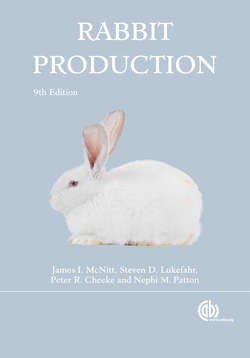Читать книгу Rabbit Production - James I McNitt - Страница 47
На сайте Литреса книга снята с продажи.
Breeding Schedule
ОглавлениеFor production of show rabbits, it may be advisable not to attempt to produce more than two or three litters a year, with the time of matings arranged so that the offspring will be of the proper age and development for the desired show classification.
For commercial meat rabbit production, the objective should be to produce and raise as many marketable fryers per doe per year as possible. It takes about 35 offspring per doe per year to meet expenses, or the equivalent of about five litters per year. Fryers may be kept with the doe until marketing at eight weeks, but the trend now is for earlier weaning and earlier breed-back, to attempt to increase productivity. Many producers now breed back at 14 or 21 days. In intensive production systems, does may even be bred within 24 hours of kindling. It is remarkable that does will rebreed immediately after giving birth; in fact, their receptivity is very good at that time. Under post-partum breeding systems, litters must be weaned at 28 days, so the does can be given nest boxes in preparation for kindling three days later. No other type of livestock has such a potential for high reproductibility as the rabbit. However, this system may increase the percentage of does that are culled annually. Intensive breeding increases nutritional requirements, so a high quality feed is needed. Intensive breeding is not recommended for new rabbit raisers. Probably a 35- or 42-day breed-back should be first selected, and if satisfactory results are obtained, it can be shortened to a period that suits the producer and his or her management skills. With early breed-back, more cages are needed than when does and litters are kept together until marketing of the fryers. This increase in caging costs may be more than compensated for by increased production. Research studies on the “best” weaning age have given mixed results. Work at Oregon State University suggested that highest profits were obtained when all cages were filled with producing does rebred 42 days after kindling. Kits were left with the does until market age; therefore, no cages were used for finishing fryers. Other studies have shown that greatest profits were obtained when does were rebred 14 days after kindling.
Various breed-back schedules, such as 7, 14, 21, 28, 35, and 42 days, are used. Generally, does are on a seven-day schedule basis, simply for ease of recordkeeping. A system that may produce greater profits and longevity of the does is to breed “depending on condition,” taking into account the number of offspring in a litter and the condition of the doe. If a doe has a small litter (less than four for medium breeds), she might be bred back in seven days if she is in good condition. However, if she has a big litter, is milking heavily, and is beginning to lose flesh, she should not be bred back until the young are weaned. It is generally agreed that breeding back at 21 or 28 days results in reduced conception.
One of the best methods to judge the body condition of a doe is to use the sense of touch. It is difficult to tell the body condition of a doe by visual examination because of the fur. Put your hands on the doe’s back and feel the back-bone and the hipbones. If these bones are prominent, the doe is in poor condition. If she is bred in this condition, she might conceive, but the next litter may be born weak or small in number or weight, or she may abort or resorb the litter. The best thing to do if the doe is in poor condition is to delay breeding until her condition improves. In commercial herds it may be best to cull the doe.
The opposite problem can occur with junior does, which can very easily become overweight, especially if they are on full feed. If they become fat (again, you can tell by feeling the body with your hands), they will not breed. They should be put on restricted feed until they reach normal condition. This can take several weeks to several months. It may be more economical to cull fat junior does and replace them with does in proper condition.
